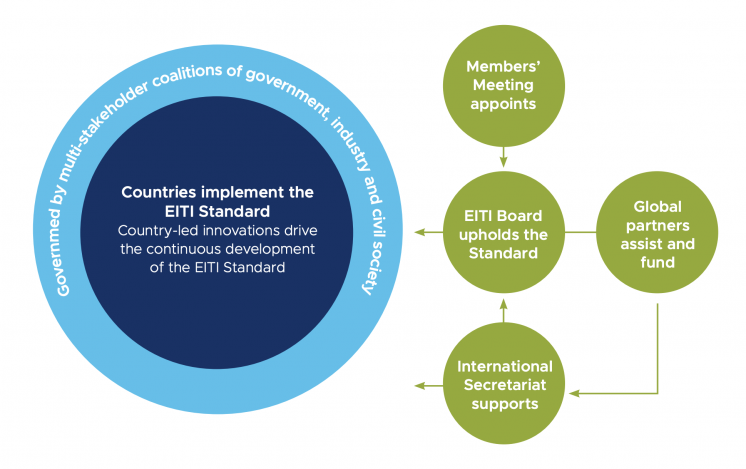
Governance
How the EITI is governed and organised
The EITI is a multi-stakeholder organisation comprised of governments of implementing and supporting countries, companies and civil society organisations. The international EITI Board serves as its main decision-making body and is supported by the EITI International Secretariat.
The EITI is governed by the EITI Articles of Association, which form part of the EITI Standard. It is registered as a non-profit association under Norwegian law.
EITI Association
The EITI, legally the “EITI Association”, consists of three permanent institutional bodies: the Members’ Meeting, the EITI Board, and the International Secretariat. Together, these bodies uphold and safeguard the EITI Standard.

As the highest governing body of the EITI, the Member’s Meeting gathers representatives from three constituency groups to elect the EITI Board every three years in connection with the EITI Global Conference.
EITI Board
The EITI Board is the EITI's main decision-making body. It decides on priorities for the organisation and evaluates countries' progress in meeting the EITI Standard.
The EITI Board is a multi-stakeholder group consisting of representatives from implementing countries, supporting countries, civil society organisations, industry and institutional investors. Each Board member, except the Board Chair, is invited to have an alternate, to observe Board meetings and deputise for the member.
The EITI Board's decision-making is consensus-based. It takes decisions during Board meetings, which are held two to four times a year, and via Board circulars.
Constituencies
The EITI Association is comprised of three constituencies – countries, companies and civil society organisations – which are represented on the EITI Board and at the Members’ Meeting. Some constituencies also have sub-constituencies that represent specific industries and geographical regions.
Constituencies are self-governing entities that appoint representatives to the Members’ Meeting and nominate members to the EITI Board. Constituencies and sub-constituencies agree guidelines to steer their nomination processes and improve accountability and information-sharing within their group.
Multi-stakeholder groups
In each implementing country, EITI implementation is led by a multi-stakeholder group (MSG) of representatives from government, industry and civil society. This group sets objectives for EITI implementation linked to each countries’ national priorities, oversees EITI reporting and ensures that disclosures contribute to public debate and reforms.
While the MSG has a mandate to determine the scope of EITI implementation in its country, the EITI Standard stipulates minimum requirements related to the role, rights and responsibilities of the MSG. This includes the full, free, active and effective engagement of government, companies and civil society.
Code of Conduct
The EITI’s Code of Conduct seeks to ensure EITI stakeholders observe the highest standards of integrity. It applies to all EITI Office Holders, including Members of the EITI Association, EITI Board members, their alternates, secretariat staff (national and international) and members of multi-stakeholder groups. It forms part of the EITI Standard.
Stakeholders who believe there is a violation of the EITI Association Code of Conduct can address this in accordance with Article 12 of the Code, which outlines the procedure for communicating concerns.
Complaint procedures
The EITI Policy on voicing concerns states that stakeholders with a concern should first raise it to the attention of the immediate EITI body (national multi-stakeholder group, EITI constituency, etc.). If this is not appropriate or if the concern remains, the stakeholder may report the concern via the EITI’s confidential online form.